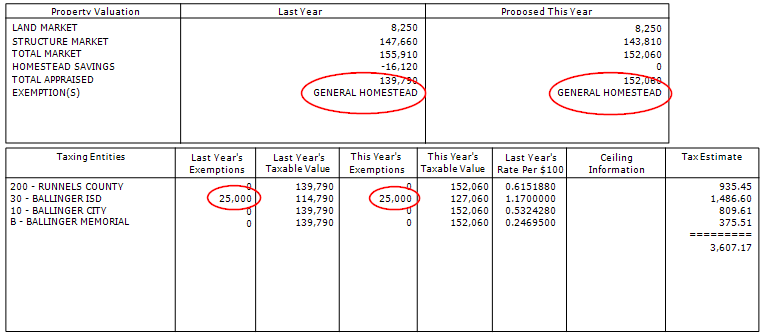When you received your Notice of Appraised Value this year, you may have noticed a line item labeled “Homestead Savings”. You may have even seen an amount last year where there is less or none this year (or vice versa) and began to panic about changes to your homestead exemption. We know this can be very confusing, so allow us to explain.
First, the “Homestead Savings” is NOT your exemption. It is something the Property Tax Code refers to in Section 23.23 as a “limitation on appraised value of residence homesteads”. In a nutshell, your residence homestead is protected from increases to the appraised (taxable) value year over year in excess of 10% per year from the date of the last appraisal plus the value of any new improvements. Check out the Homesteads page for a more detailed example of how this limitation, also known as a homestead cap loss, is calculated and how it can affect your bottom line.
How do I know my homestead exemption is still active?
Look at the Exemption(s) line under the previous and current years’ value comparisons, as well as the Last Year’s/This Year’s Exemptions columns in the estimated tax breakdown below that. If one or both of these exemption fields for This Year is blank or “0”, give us a call so we can make sure your exemption is being applied correctly.

How does the Homestead Cap Loss benefit me?
Appraisal Districts are required by law to determine the value of properties in the county based on today’s market by both sales and cost analyses using schedules and classification systems. The homestead cap helps you by slowing down the effect on your tax bill of any value increase to your homestead property. This means, even if your property value has seen an increase of 22%, for example, from the last time it was appraised (which could be up to three years ago), your appraised or taxable value will increase only up to ten percent each year. As a result, you won’t see a huge increase to the amount you pay in taxes all at once.
Why is the Homestead Savings a negative number?
The homestead savings or cap is a reflection of both the difference between your appraised/taxable value (the portion of your property’s market value you’re actually being taxed on) and the market value (what we say the property would be worth in today’s market) as well as the portion of market value that is being exempted or withheld from taxation. So as your appraised value increases each year by 10%, the gap between your appraised and market value gets smaller. Assuming no further increases to the market value of your property, you should see the ‘homestead savings’ number shrink until eventually it reaches zero and you are finally taxed at your home’s market value.
I bought my house last year and qualified for a Residence Homestead Exemption for the first time this year. Why did my appraised value increase more than ten percent from last year? My Notice of Appraised Value shows no homestead savings for me this year.
Unlike tax ceilings for disabled or elderly homeowners, homestead caps cannot transfer if the ownership of the property changes hands. The Property Tax Code 23.23(c) states a homeowner must have received the homestead exemption in both the previous and current years in order to be eligible for the homestead cap. Since homestead eligibility is determined as of January 1st, the previous owner’s cap would have remained in effect for the duration of the year you bought the property. As of January 1 of the following year, the property’s appraised/taxable value would be adjusted to its market value and you would not only have to qualify for your own homestead exemption but would also be responsible for paying taxes at full market value. Should there be any further increases in excess of ten percent to market value in subsequent years, you would certainly be able to take advantage of the homestead cap at that point.
Since the Tax Code clearly defines homestead exemption qualifications, homestead appraised value limitations, and all the rules and restrictions that go along with both, the Appraisal District is not able to affect any changes on your homestead savings. The most we can do is help you determine if and when you are eligible for an exemption and assist with completing the appropriate exemption application.
My value increased because I added on to my house, but my appraised value is still increasing more than 10%. Why?
Any structures, additions, or other new improvements to a property since the last time it was appraised will not calculate toward the homestead cap. The cap is intended to assist homeowners with value increases to buildings that were already on the property (and on the tax roll) in previous years; you will have to pay taxes this year on the full amount of any value your new home addition is contributing to the property.
In closing…
It is important for all property owners, but especially homeowners, to pay close attention to their property’s market value rather than simply looking at the final estimated tax amount or taxable value. This is ultimately our determination of what your property is worth in the current market, and this is the value you should protest if you believe this year’s assessment is unfair for your property.
